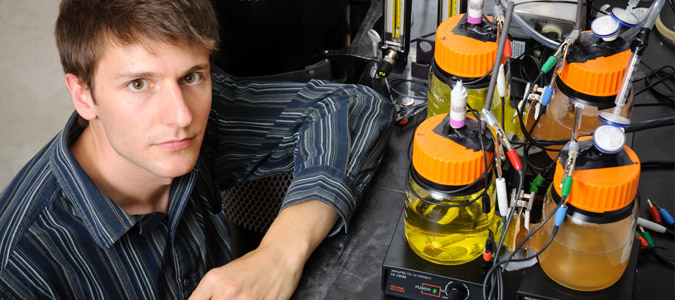Young innovator unleashes electrical power of microbes
Jonathan Godwin, a University of Saskatchewan master’s student, is improving a new “green” energy source — creating electrical fuel cells from everyday microbes.
By Victoria Martinez "I thought it was fascinating that you could get electricity from a living thing," Godwin said. "It doesn't seem possible at first glance."
"I thought it was fascinating that you could get electricity from a living thing," Godwin said. "It doesn't seem possible at first glance."
It is in fact already possible to generate electrical energy from microbes in fuel cells, but Godwin, under the supervision of chemical engineering professor Richard Evitts, hopes to improve the new technology.
Microbe-based fuel cells are a tantalizing green energy solution — all you need to make one is a circuit, a microbe such as yeast, food for the microbe and chemicals to turn them into an electrical source. The system is so flexible that any organic material, from jelly to garbage, could be used as food for the fuel cell.
Since biological processes work by passing electrons — it takes energy for microbes to digest food, for example — they all have the potential to create electricity.
Normally, the electrical energy is redirected into a circuit by mixing chemicals called mediators into the food and microbe mixture to allow the harvest of electricity.
But chemical mediators are expensive and often toxic — potentially making toxic all the byproducts of electricity-microbes.
But since "green" and "toxic" can't exist in the same technology, Godwin is working on a kind of fuel cell that avoids mixing in the dangerous mediators.
"Jon has managed to coat electrodes with the mediators so there could be a more direct way of harnessing the electricity," Evitts said.
In the fuel cell, yeast grows on the chemical-coated electrode. The electricity is collected as a byproduct while the yeast goes through its normal processes of digesting sugar and producing alcohol.
This way, the chemicals don't turn normal microbial processes into toxic ones.
Once researchers master gathering electricity from everyday microbes using coated electrodes, the same principles should be applicable in a variety of microbiological systems.
For example, alcohol-producing yeast can be used for brewing and to produce electricity at the same time. The University of Queensland together with Foster's Brewing in Australia has already tested a pilot version of a microbial fuel cell set up.
"We're trying to use systems that produce an already useful byproduct," Godwin said.
But there is one major drawback to this kind of microbial fuel cell: Mediator-coated electrodes produce a lot less electricity than simply mixing the mediators into the solution.
To amp up the electrical power in their cells, Godwin and Evitts are using another naturally occurring process: Photosynthesis, the process plants use to turn sunlight into energy. In this case, they are adding green microalgae to the system.
"The electrons aid in photosynthesis, which is an energy-intensive process," Godwin said.
The coated electrode takes electrons from the yeast and sends them through a circuit to the micro-algae, which then use the electrons in photosynthesis. Once this technology is developed, the electrical current flowing through the circuit could be used to power electrical devices.
"This is a fairly new area of research," he said, adding that high-energy coated fuel cells are still years away from being used on a large scale.
To help pursue his research, Godwin was awarded a graduate teaching fellowship from the U of S engineering college. Evitts is part of a group of researchers awarded a strategic project grant from the Canadian funding agency NSERC to work in the area.

